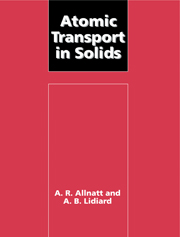Book contents
- Frontmatter
- Contents
- Preface
- List of principal symbols
- 1 Atomic movements in solids – phenomenological equations
- 2 Imperfections in solids
- 3 Statistical thermodynamics of crystals containing point defects
- 4 Non-equilibrium thermodynamics of atomic transport processes in solids
- 5 Some applications of non-equilibrium thermodynamics to solids
- 6 Microscopic theories – the master equation
- 7 Kinetic theory of relaxation processes
- 8 Kinetic theory of isothermal diffusion processes
- 9 The theory of random walks
- 10 Random-walk theories of atomic diffusion
- 11 Transport coefficients of dilute solid solutions – results and applications
- 12 The evaluation of nuclear magnetic relaxation rates
- 13 Theories of concentrated and highly defective systems
- References
- Index
4 - Non-equilibrium thermodynamics of atomic transport processes in solids
Published online by Cambridge University Press: 28 December 2009
- Frontmatter
- Contents
- Preface
- List of principal symbols
- 1 Atomic movements in solids – phenomenological equations
- 2 Imperfections in solids
- 3 Statistical thermodynamics of crystals containing point defects
- 4 Non-equilibrium thermodynamics of atomic transport processes in solids
- 5 Some applications of non-equilibrium thermodynamics to solids
- 6 Microscopic theories – the master equation
- 7 Kinetic theory of relaxation processes
- 8 Kinetic theory of isothermal diffusion processes
- 9 The theory of random walks
- 10 Random-walk theories of atomic diffusion
- 11 Transport coefficients of dilute solid solutions – results and applications
- 12 The evaluation of nuclear magnetic relaxation rates
- 13 Theories of concentrated and highly defective systems
- References
- Index
Summary
Introduction
In Chapter 1 we briefly introduced the extended macroscopic equations of atomic transport that are provided by non-equilibrium thermodynamics. In this chapter and the next we expand this description, in this chapter in general terms and then in the next by a series of applications. The objectives are (i) to show how to use the description provided by non-equilibrium thermodynamics and (ii) to focus attention on the corresponding transport coefficients (denoted by Lij) and the expressions of various practical transport coefficients in terms of them. By working in terms of these basic L-coefficients we obtain a better understanding of the relations among the various practical coefficients and we provide a more sharply defined objective for the statistical atomic theories to be developed later.
The subject of non-equilibrium thermodynamics is now supported by a considerable body of statistical mechanical theory. Since our interest in this book lies primarily with the use of this formalism and with the calculation of the quantities appearing in it, it is not appropriate to go into this body of general theory widely. For this purpose we refer the reader to the books by de Groot and Mazur (1962) and by Haase (1969) for wide-ranging treatments, especially of the use of the macroscopic formulation, and to Kreuzer (1981) for a more recent account which emphasizes the general statistical mechanical foundations of this formalism. Here, a less extensive review will be given of those aspects pertinent to our interest in atomic transport in solids.
As we have already pointed out in §1.4 the immediately obvious features of the formalism are threefold: …
- Type
- Chapter
- Information
- Atomic Transport in Solids , pp. 161 - 180Publisher: Cambridge University PressPrint publication year: 1993
- 1
- Cited by

